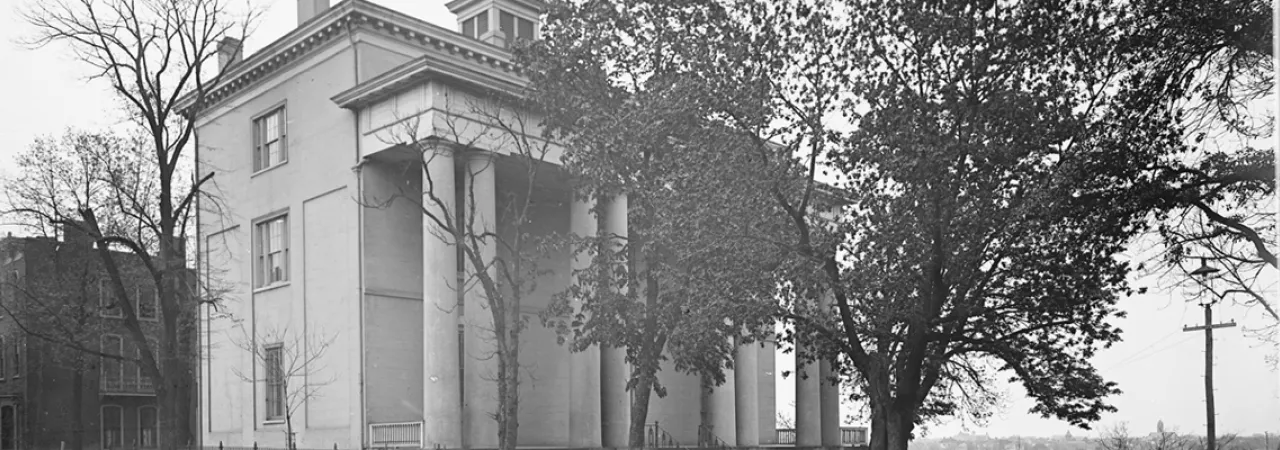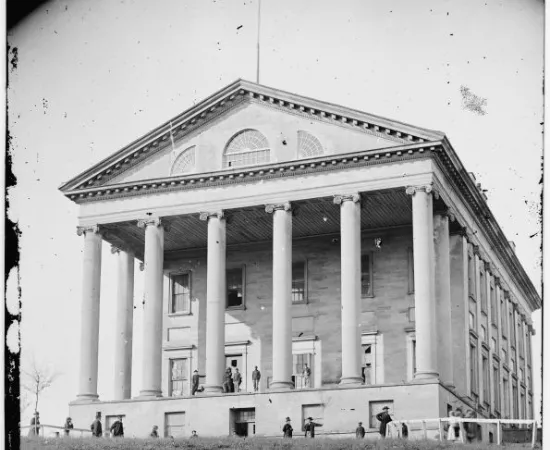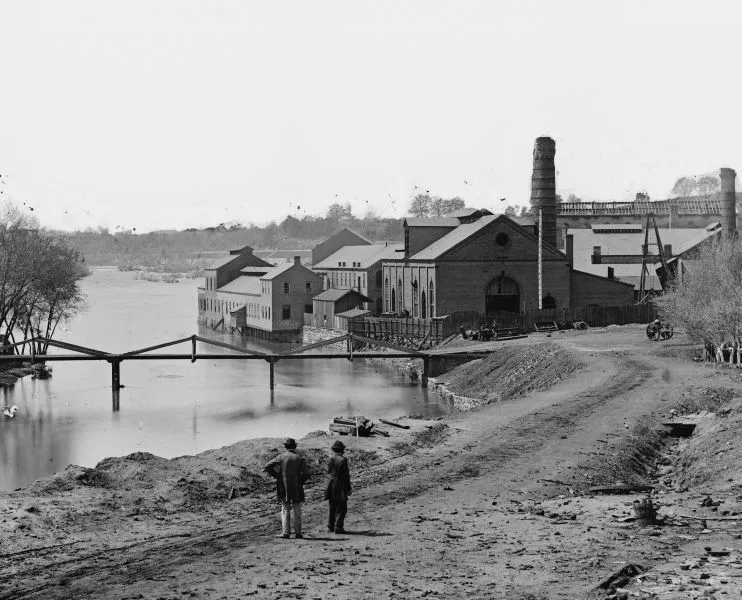
Richmond, Virginia, was the capital of the Confederate States of America during the Civil War. While it is most notably known for being the South's political capital, Richmond transformed as a city throughout the course of the war from an agricultural town to an industrial powerhouse. At the conclusion of the tumultuous four-year period of the Civil War, Richmond lay in ruins, a cityscape ravaged by war.

In 1860, much of Virginia was originally opposed to secession due to the strong economic ties to the Union through the tobacco industry, its agricultural trade, and the manufacturing powerhouse Tredegar Ironworks that produced iron used in railroads and weapons for the Federal stockpile.
When Virginia seceded from the Union on April 17th, 1861 (ratified on May 23, 1861), the debate of whether to move the capital of the Confederacy from Montgomery, Alabama, to Richmond, Virginia, was a hot topic. Confederate Vice President Alexander Stephens believed moving the capital would provide Virginians with an incentive to fight for the Confederacy. Richmond’s proximity to Washington, D.C., would rally Virginians to fight for the newly formed Confederacy. Richmond also had an important symbolic history from the Revolutionary War era. Stephens, along with other Confederates knew of Patrick Henry’s “Give me Liberty or Give me Death” speech delivered in Richmond; they also knew that Thomas Jefferson designed the Capitol building in Richmond. The symbolic history of Richmond was one reason for moving the capital, as Montgomery, Alabama, did not have such historic roots. Practically, however, Richmond was the most industrialized city in the South, as well as one of the few cities in the South with a large railroad network and provided a greater industrial advantage to the Confederacy than Montgomery could.
During the war, Richmond morphed into an anarchic city that was riddled with crime. As Richmond’s population exponentially expanded due to an increase in Confederate officials from other states moving to the capital, soldiers traveling in and out of the city, and the growth of war industries, criminal activity was widespread throughout Richmond. Whiskey shops lined Main Street and furloughed soldiers sprawled out on sidewalks in their drunken stupor. At the beginning of the war, drunken soldiers were the main cause of criminal activity in Richmond. Most civilians did not engage in criminal activity until the middle and end of the war. Civilians would pickpocket passersby’s, and some would raid backyard gardens when there were food shortages. On April 2nd, 1863, the Richmond Bread Riot took place due to the rising cost of food and other necessities. Rioters took to the streets looting for two hours until the Confederate military threatened action against them. The Bread Riot increased the city’s awareness of how desperate the city had become for necessities and tried to make amends with starving Richmonders.
Richmond was the medical frontline to wounded soldiers arriving from the frontlines of battle. The largest hospital tending to wounded soldiers in Richmond was Chimborazo, located on a hill in the eastern part of the city. Chimborazo served as the largest hospital for the Confederacy and had one of the lowest mortality rates. The Medical College of Virginia (MCV) was one of the only medical southern schools that remained open and graduated classes throughout the entirety of the war. MCV’s recently constructed hospital in 1860 assisted in the treatment of wounded soldiers during the war, providing relief to Chimborazo as well as other field hospitals that were active in Richmond.

Richmond was the home of many enslaved individuals, and the war drastically impacted their lives. Before the Civil War, Virginia had the largest number of enslaved people in any Southern state. Slavery was the backbone of the Confederate workforce, especially in Richmond. Enslaved people in Richmond worked in all facets of the war. They worked on plantations to cultivate food and consumer goods such as cotton and tobacco. They worked in the industrial sector in Tredegar Ironworks as more white workers were needed by the Confederate army. Enslaved individuals were put to work at the Chimborazo Field Hospital as nurses and cooks. Slaves were also forced to build fortifications for the defenses of Richmond and Petersburg.
In 1865, Richmond and her surrounding neighbors experienced a long and drawn-out siege. Dubbed the Siege of Petersburg, the siege itself was a multitude of brutal trench warfare battles fought along a line outside of Petersburg, stretching north toward Richmond, and lasting for 292 days. Recently appointed General Ulysses S. Grant was at the mantle of the siege. Grant hoped to break a stalemate between the Union and the Confederacy by taking the fight directly to Robert E. Lee’s army. Grant bottled up Lee’s forces around Richmond and Petersburg, which in turn allowed the Federals to engage with Confederate forces in other sectors, and to seize or destroy southern war materials. Throughout the siege, Grant attempted to attack at Petersburg and Richmond simultaneously, which would apply pressure so that rebel forces could not shift reinforcements to threatened points.

Following the crushing defeat at the Siege of Petersburg, the Confederate government began to evacuate from Richmond. While evacuating teh city, Confederate soldiers burned any military supplies that they did not want to fall into Union hands. The fire could not be contained by the fire department due to a breeze that carried the fires across the city. After having no other choice, the mayor of Richmond relinquished control of the city to Union forces to extinguish the fires. On April 4th, President Abraham Lincoln visited Richmond and the former Confederate White House, along with the Virginia State Capital. Lincoln was met with a deafening roar of praise by newly freed slaves all along his route through the fallen Confederate capital. As Richmond finally fell after nearly four years of war, what was left General Robert E. Lee’s army trudged west, eventually finding themselves without supplies and cutoff by Federal forces at Appomattox. Lee surrendered to Grant on April 9th, 1865, with the official surrender ceremonies taking place on April 12th, 1865.
After the war, Richmond rebuilt itself from the ashes of the Confederacy. The lengthy process of reconstruction proved to be a challenging task for many Richmonders. State officials in Richmond rewrote Virginia’s Constitution that provided a sensible change that appealed to both Democrats and Republicans in Virginia.
Following the war, many deceased Confederate military officials were interred in Richmond, specifically Hollywood Cemetery. Hollywood Cemetery is the final resting place to officials such as former Confederate President Jefferson Davis, along with 25 Confederate generals including: J.E.B. Stuart, George Pickett, Fitzhugh Lee, and Henry Heth. Hollywood Cemetery is also the final resting place of former United States Presidents James Monroe and John Tyler. Hollywood Cemetery houses the remains of thousands of Confederate soldiers, as well as a large stone pyramid dedicated to 18,000 unknown Confederate soldiers. After the war, Richmond erected many markers and monuments commemorating the Confederate soldiers and generals who fought in the war on the famous Monument Avenue.
Richmond played an extremely significant part in the Civil War. Not only was it the headquarters of the Confederacy, but the city played a crucial part in executing the Confederacy’s war effort. From industrial centers manufacturing artillery and armaments to field hospitals tending to the wounded, Richmond during the Civil War was a city that took on the challenge of becoming a symbol for the Confederacy.
Further Reading
- Rebel Richmond: Life and Death in the Confederate Capital: By Stephen B. Ash
- Confederate Citadel: Richmond and Its People at War: By Mary A. DeCredico
- Rearing Wolves to Our Own Destruction: Slavery in Richmond, Virginia, 1782-1865: By Midori Takagi
- The Richmond Slave Trade: The Economic Backbone of the Old Dominion: By Jack Trammell
- To the Gates of Richmond: The Peninsula Campaign: By Stephen W. Sears
Related Battles
8,150
3,236
3,500
4,250





